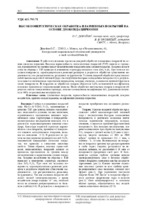| dc.contributor.author | Девойно, О. Г. | ru |
| dc.contributor.author | Оковитый, В. В. | ru |
| dc.coverage.spatial | Кемерово | ru |
| dc.date.accessioned | 2018-04-09T07:29:45Z | |
| dc.date.available | 2018-04-09T07:29:45Z | |
| dc.date.issued | 2015 | |
| dc.identifier.citation | Девойно, О. Г. Высокоэнергетическая обработка плазменных покрытий на основе диоксида циркония / О. Г. Девойно, В. В. Оковитый // Инновации в машиностроении (ИНМАШ-2015) : сборник трудов VII Международной научно-практической конференции, Кемерово, 23-25 сентября 2015 г. – Кемерово, 2015. – С. 342-347. | ru |
| dc.identifier.uri | https://rep.bntu.by/handle/data/40120 | |
| dc.description.abstract | В работе исследованы процессы лазерной обработки плазменных покрытий на основе диоксида циркония. Высокая термостойкость теплозащитных покрытий (ТЗП) зависит от процессов, протекающих на границе между металлическим и керамическим слоями покрытия. Лазерное воздействие на образцы с ТЗП приводит к изменению структуры оксидного слоя ZrO2-Y2O3. При этом его исходная поверхность, характеризующаяся развитым рельефом в результате обработки существенно выравнивается, оно растрескивается, разделяясь на фрагменты. Условия лазерной обработки представляют собой высокоскоростной тепловой удар с последующим быстрым охлаждением поверхности, в результате создаются значительные термические напряжения, которые, очевидно, и являются причиной фрагментации поверхности. | ru |
| dc.language.iso | ru | ru |
| dc.publisher | Кузбасский государственный технический университет имени Т. Ф. Горбачева | ru |
| dc.title | Высокоэнергетическая обработка плазменных покрытий на основе диоксида циркония | ru |
| dc.title.alternative | High energy plasma treatment coatings based on zirconium dioxide | en |
| dc.type | Article | ru |
| local.description.annotation | In the paper processes of laser processing plasma coating based on zirconium dioxide. High temperature resistant thermal barrier coatings (TBC) depends on the processes occurring at the interface between the metal and the ceramic coating layers. The laser effect on samples with HRC leads to changes in the structure of the oxide layer of ZrO2-Y2O3. While its initial surface characterized by the development relief treating substantially aligned, it cracked, broken into fragments. Conditions of laser treatment are high thermal shock followed by rapid cooling of the surface, as a result creates a significant thermal stress, which, obviously, are the cause of the fragmentation surface. The coating is formed by laser processing to 6.6% of the monoclinic modification, the rest almost tetragonal dioxide. After treatment, a pulsed laser is formed in the coating strongly crushed structure disappears monoclinic ZrO2 actually get 100% tetragonal modification. | en |

